Analysis of Heart Failure Studies and Research
VerifiedAdded on 2021/04/21
|10
|2625
|32
AI Summary
This assignment provides a comprehensive overview of various studies and research papers related to heart failure. It includes articles and reports from reputable sources such as the American Heart Association, Archives of Internal Medicine, and Circulation: Heart Failure. The studies cover topics such as the causes and treatment outcomes of acute heart failure in Africans, the application of receiver operating characteristic analysis to predict potential digoxin drug interactions, transitional care interventions to prevent readmissions for persons with heart failure, forecasting the impact of heart failure in the United States, and epidemiology of cardiovascular disease. The assignment requires careful analysis and understanding of the research findings and their implications for clinical practice.
Contribute Materials
Your contribution can guide someone’s learning journey. Share your
documents today.
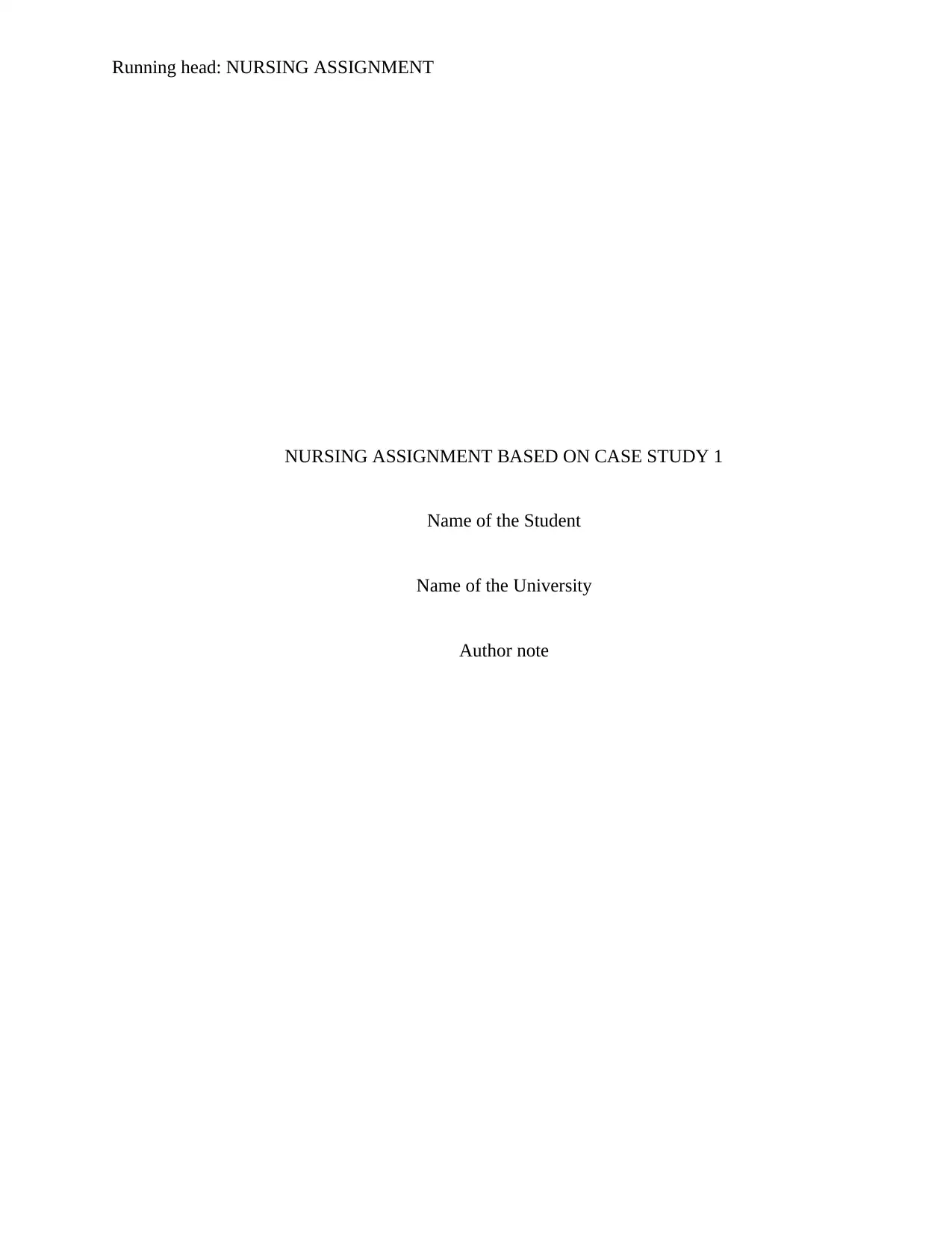
Running head: NURSING ASSIGNMENT
NURSING ASSIGNMENT BASED ON CASE STUDY 1
Name of the Student
Name of the University
Author note
NURSING ASSIGNMENT BASED ON CASE STUDY 1
Name of the Student
Name of the University
Author note
Secure Best Marks with AI Grader
Need help grading? Try our AI Grader for instant feedback on your assignments.
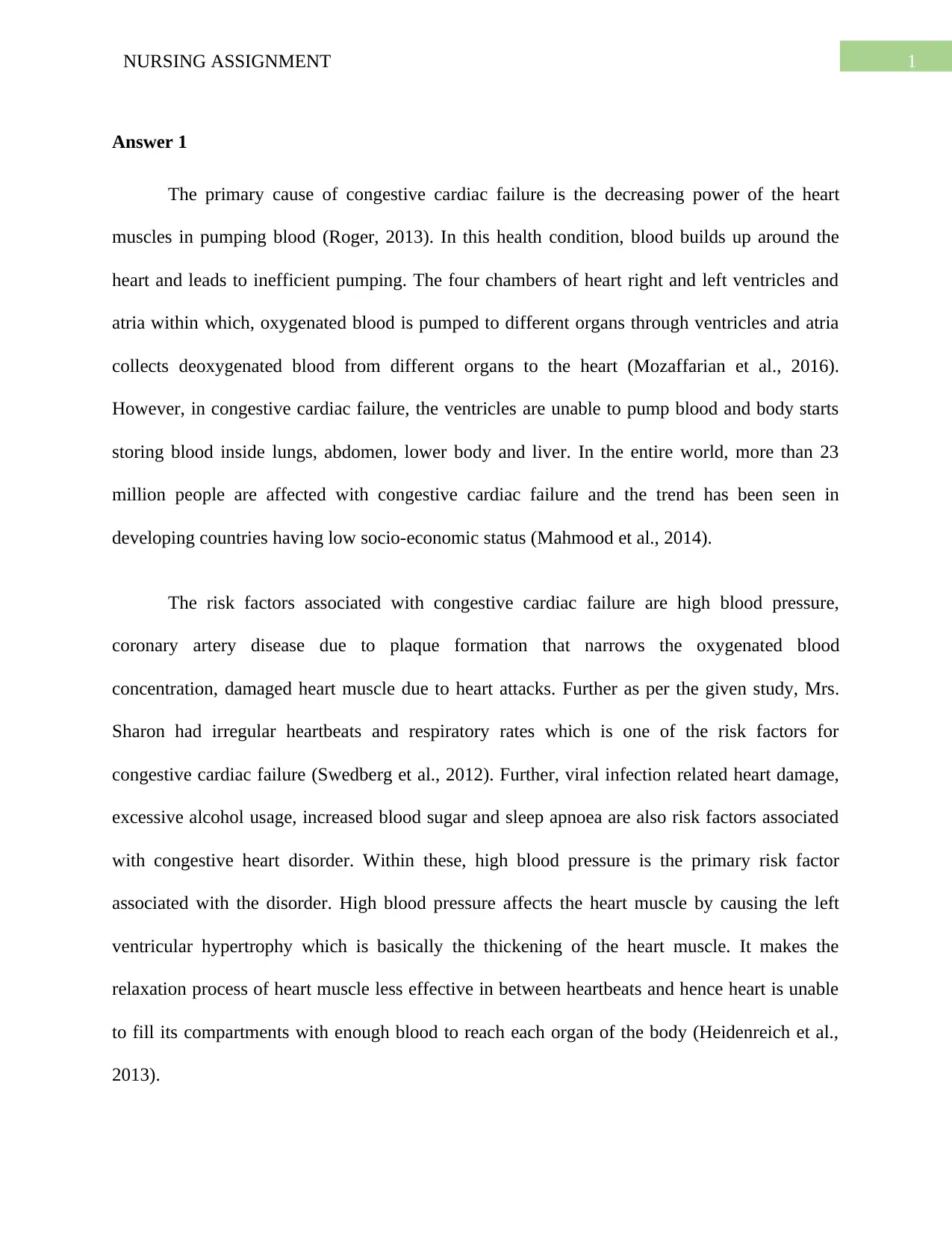
1NURSING ASSIGNMENT
Answer 1
The primary cause of congestive cardiac failure is the decreasing power of the heart
muscles in pumping blood (Roger, 2013). In this health condition, blood builds up around the
heart and leads to inefficient pumping. The four chambers of heart right and left ventricles and
atria within which, oxygenated blood is pumped to different organs through ventricles and atria
collects deoxygenated blood from different organs to the heart (Mozaffarian et al., 2016).
However, in congestive cardiac failure, the ventricles are unable to pump blood and body starts
storing blood inside lungs, abdomen, lower body and liver. In the entire world, more than 23
million people are affected with congestive cardiac failure and the trend has been seen in
developing countries having low socio-economic status (Mahmood et al., 2014).
The risk factors associated with congestive cardiac failure are high blood pressure,
coronary artery disease due to plaque formation that narrows the oxygenated blood
concentration, damaged heart muscle due to heart attacks. Further as per the given study, Mrs.
Sharon had irregular heartbeats and respiratory rates which is one of the risk factors for
congestive cardiac failure (Swedberg et al., 2012). Further, viral infection related heart damage,
excessive alcohol usage, increased blood sugar and sleep apnoea are also risk factors associated
with congestive heart disorder. Within these, high blood pressure is the primary risk factor
associated with the disorder. High blood pressure affects the heart muscle by causing the left
ventricular hypertrophy which is basically the thickening of the heart muscle. It makes the
relaxation process of heart muscle less effective in between heartbeats and hence heart is unable
to fill its compartments with enough blood to reach each organ of the body (Heidenreich et al.,
2013).
Answer 1
The primary cause of congestive cardiac failure is the decreasing power of the heart
muscles in pumping blood (Roger, 2013). In this health condition, blood builds up around the
heart and leads to inefficient pumping. The four chambers of heart right and left ventricles and
atria within which, oxygenated blood is pumped to different organs through ventricles and atria
collects deoxygenated blood from different organs to the heart (Mozaffarian et al., 2016).
However, in congestive cardiac failure, the ventricles are unable to pump blood and body starts
storing blood inside lungs, abdomen, lower body and liver. In the entire world, more than 23
million people are affected with congestive cardiac failure and the trend has been seen in
developing countries having low socio-economic status (Mahmood et al., 2014).
The risk factors associated with congestive cardiac failure are high blood pressure,
coronary artery disease due to plaque formation that narrows the oxygenated blood
concentration, damaged heart muscle due to heart attacks. Further as per the given study, Mrs.
Sharon had irregular heartbeats and respiratory rates which is one of the risk factors for
congestive cardiac failure (Swedberg et al., 2012). Further, viral infection related heart damage,
excessive alcohol usage, increased blood sugar and sleep apnoea are also risk factors associated
with congestive heart disorder. Within these, high blood pressure is the primary risk factor
associated with the disorder. High blood pressure affects the heart muscle by causing the left
ventricular hypertrophy which is basically the thickening of the heart muscle. It makes the
relaxation process of heart muscle less effective in between heartbeats and hence heart is unable
to fill its compartments with enough blood to reach each organ of the body (Heidenreich et al.,
2013).
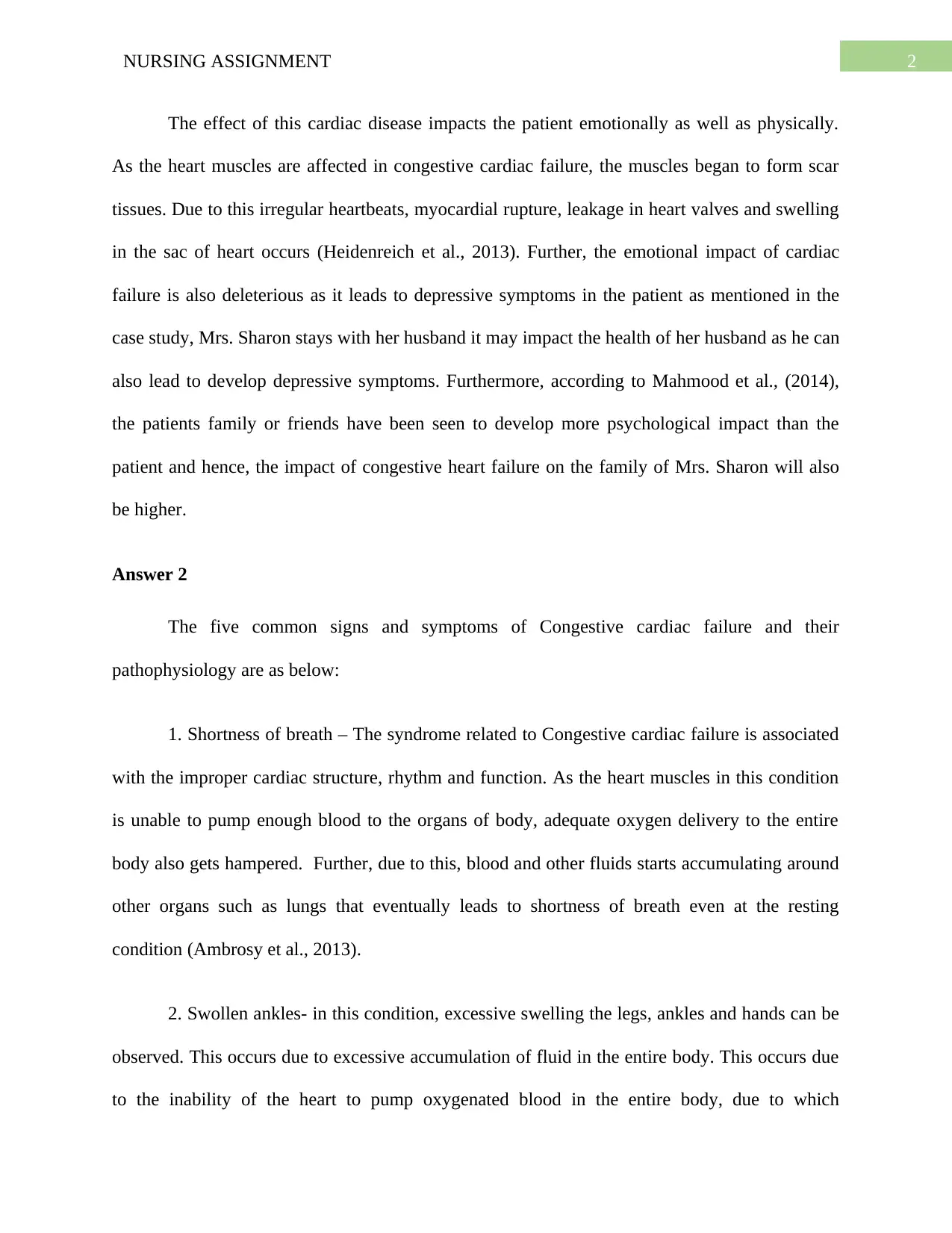
2NURSING ASSIGNMENT
The effect of this cardiac disease impacts the patient emotionally as well as physically.
As the heart muscles are affected in congestive cardiac failure, the muscles began to form scar
tissues. Due to this irregular heartbeats, myocardial rupture, leakage in heart valves and swelling
in the sac of heart occurs (Heidenreich et al., 2013). Further, the emotional impact of cardiac
failure is also deleterious as it leads to depressive symptoms in the patient as mentioned in the
case study, Mrs. Sharon stays with her husband it may impact the health of her husband as he can
also lead to develop depressive symptoms. Furthermore, according to Mahmood et al., (2014),
the patients family or friends have been seen to develop more psychological impact than the
patient and hence, the impact of congestive heart failure on the family of Mrs. Sharon will also
be higher.
Answer 2
The five common signs and symptoms of Congestive cardiac failure and their
pathophysiology are as below:
1. Shortness of breath – The syndrome related to Congestive cardiac failure is associated
with the improper cardiac structure, rhythm and function. As the heart muscles in this condition
is unable to pump enough blood to the organs of body, adequate oxygen delivery to the entire
body also gets hampered. Further, due to this, blood and other fluids starts accumulating around
other organs such as lungs that eventually leads to shortness of breath even at the resting
condition (Ambrosy et al., 2013).
2. Swollen ankles- in this condition, excessive swelling the legs, ankles and hands can be
observed. This occurs due to excessive accumulation of fluid in the entire body. This occurs due
to the inability of the heart to pump oxygenated blood in the entire body, due to which
The effect of this cardiac disease impacts the patient emotionally as well as physically.
As the heart muscles are affected in congestive cardiac failure, the muscles began to form scar
tissues. Due to this irregular heartbeats, myocardial rupture, leakage in heart valves and swelling
in the sac of heart occurs (Heidenreich et al., 2013). Further, the emotional impact of cardiac
failure is also deleterious as it leads to depressive symptoms in the patient as mentioned in the
case study, Mrs. Sharon stays with her husband it may impact the health of her husband as he can
also lead to develop depressive symptoms. Furthermore, according to Mahmood et al., (2014),
the patients family or friends have been seen to develop more psychological impact than the
patient and hence, the impact of congestive heart failure on the family of Mrs. Sharon will also
be higher.
Answer 2
The five common signs and symptoms of Congestive cardiac failure and their
pathophysiology are as below:
1. Shortness of breath – The syndrome related to Congestive cardiac failure is associated
with the improper cardiac structure, rhythm and function. As the heart muscles in this condition
is unable to pump enough blood to the organs of body, adequate oxygen delivery to the entire
body also gets hampered. Further, due to this, blood and other fluids starts accumulating around
other organs such as lungs that eventually leads to shortness of breath even at the resting
condition (Ambrosy et al., 2013).
2. Swollen ankles- in this condition, excessive swelling the legs, ankles and hands can be
observed. This occurs due to excessive accumulation of fluid in the entire body. This occurs due
to the inability of the heart to pump oxygenated blood in the entire body, due to which
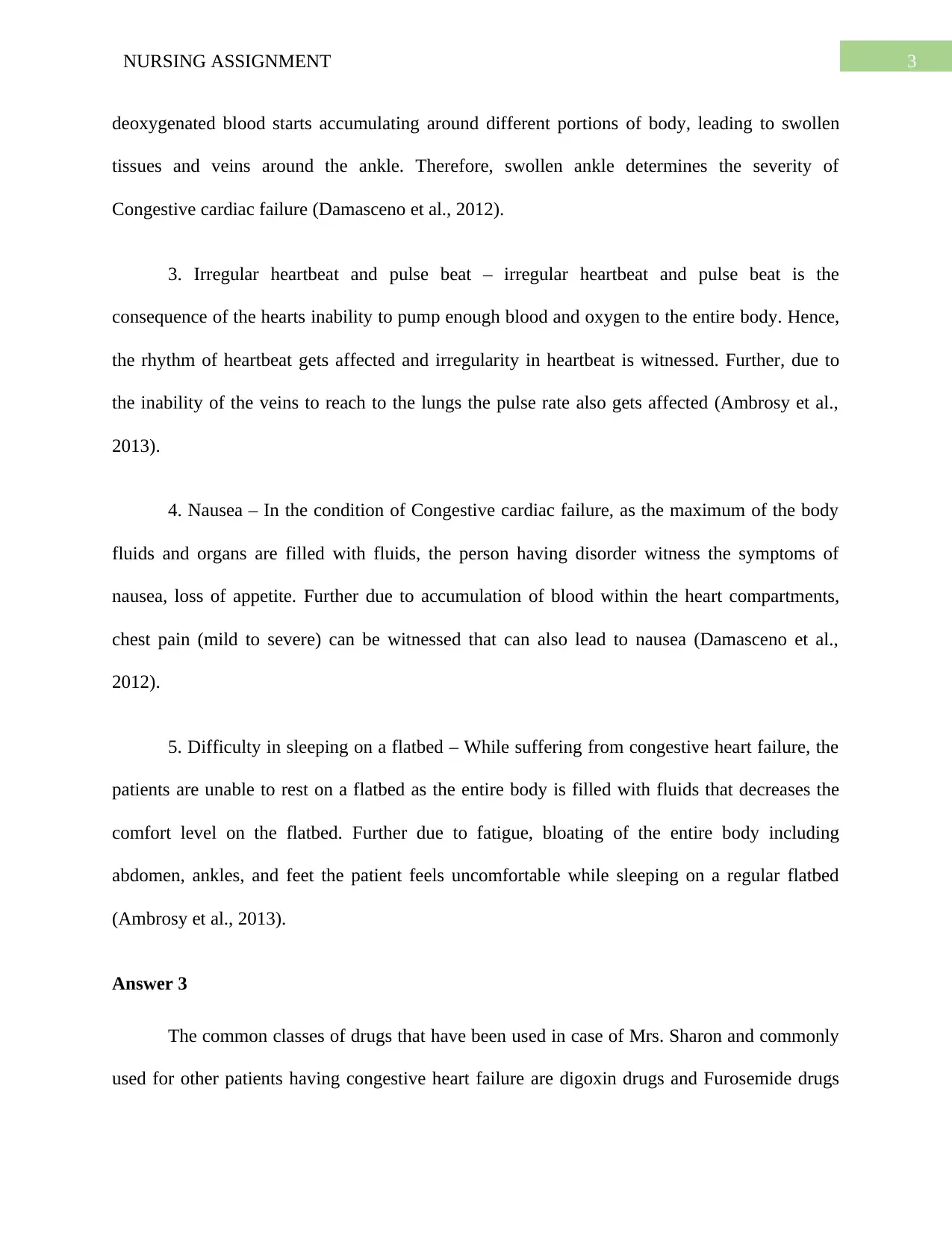
3NURSING ASSIGNMENT
deoxygenated blood starts accumulating around different portions of body, leading to swollen
tissues and veins around the ankle. Therefore, swollen ankle determines the severity of
Congestive cardiac failure (Damasceno et al., 2012).
3. Irregular heartbeat and pulse beat – irregular heartbeat and pulse beat is the
consequence of the hearts inability to pump enough blood and oxygen to the entire body. Hence,
the rhythm of heartbeat gets affected and irregularity in heartbeat is witnessed. Further, due to
the inability of the veins to reach to the lungs the pulse rate also gets affected (Ambrosy et al.,
2013).
4. Nausea – In the condition of Congestive cardiac failure, as the maximum of the body
fluids and organs are filled with fluids, the person having disorder witness the symptoms of
nausea, loss of appetite. Further due to accumulation of blood within the heart compartments,
chest pain (mild to severe) can be witnessed that can also lead to nausea (Damasceno et al.,
2012).
5. Difficulty in sleeping on a flatbed – While suffering from congestive heart failure, the
patients are unable to rest on a flatbed as the entire body is filled with fluids that decreases the
comfort level on the flatbed. Further due to fatigue, bloating of the entire body including
abdomen, ankles, and feet the patient feels uncomfortable while sleeping on a regular flatbed
(Ambrosy et al., 2013).
Answer 3
The common classes of drugs that have been used in case of Mrs. Sharon and commonly
used for other patients having congestive heart failure are digoxin drugs and Furosemide drugs
deoxygenated blood starts accumulating around different portions of body, leading to swollen
tissues and veins around the ankle. Therefore, swollen ankle determines the severity of
Congestive cardiac failure (Damasceno et al., 2012).
3. Irregular heartbeat and pulse beat – irregular heartbeat and pulse beat is the
consequence of the hearts inability to pump enough blood and oxygen to the entire body. Hence,
the rhythm of heartbeat gets affected and irregularity in heartbeat is witnessed. Further, due to
the inability of the veins to reach to the lungs the pulse rate also gets affected (Ambrosy et al.,
2013).
4. Nausea – In the condition of Congestive cardiac failure, as the maximum of the body
fluids and organs are filled with fluids, the person having disorder witness the symptoms of
nausea, loss of appetite. Further due to accumulation of blood within the heart compartments,
chest pain (mild to severe) can be witnessed that can also lead to nausea (Damasceno et al.,
2012).
5. Difficulty in sleeping on a flatbed – While suffering from congestive heart failure, the
patients are unable to rest on a flatbed as the entire body is filled with fluids that decreases the
comfort level on the flatbed. Further due to fatigue, bloating of the entire body including
abdomen, ankles, and feet the patient feels uncomfortable while sleeping on a regular flatbed
(Ambrosy et al., 2013).
Answer 3
The common classes of drugs that have been used in case of Mrs. Sharon and commonly
used for other patients having congestive heart failure are digoxin drugs and Furosemide drugs
Secure Best Marks with AI Grader
Need help grading? Try our AI Grader for instant feedback on your assignments.
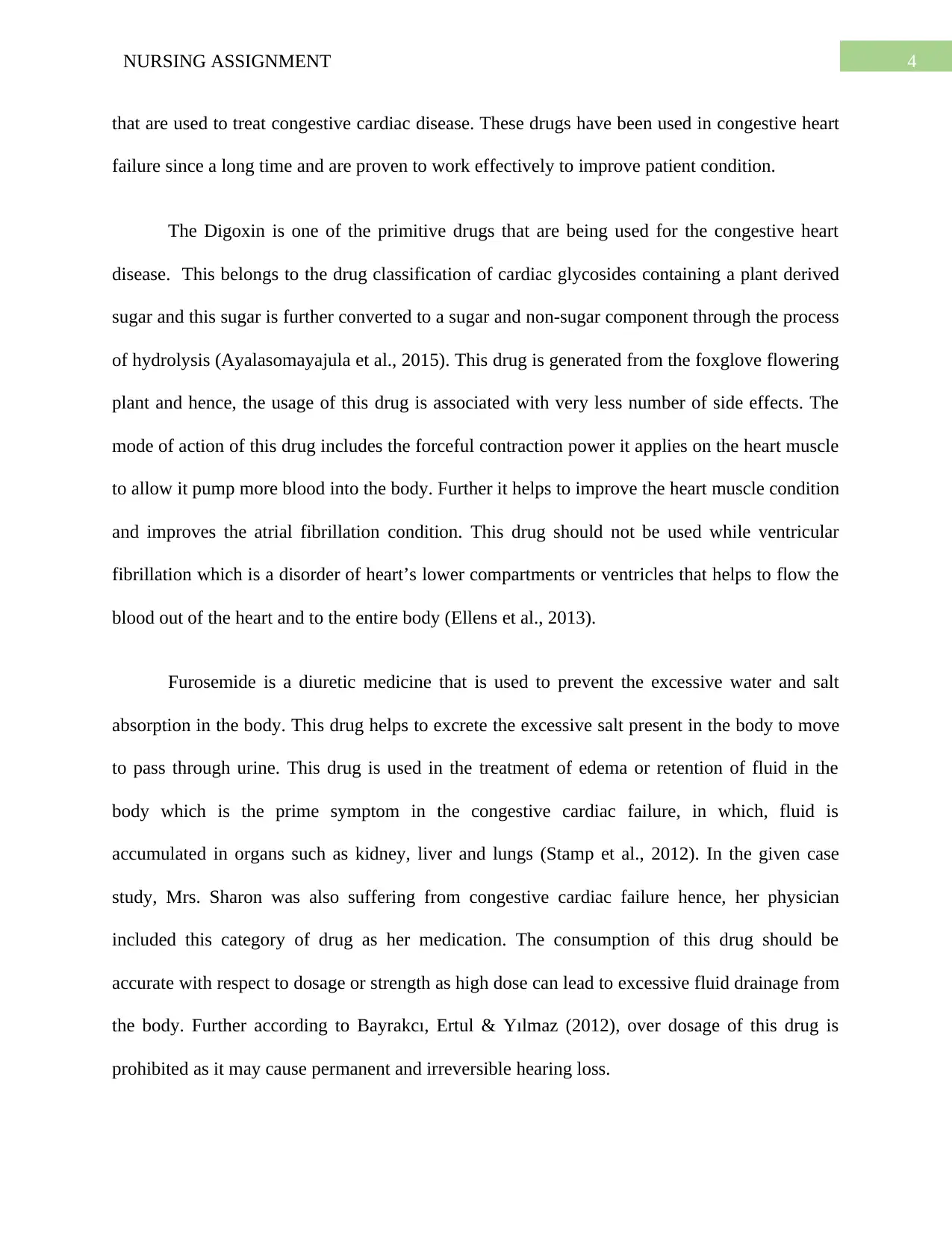
4NURSING ASSIGNMENT
that are used to treat congestive cardiac disease. These drugs have been used in congestive heart
failure since a long time and are proven to work effectively to improve patient condition.
The Digoxin is one of the primitive drugs that are being used for the congestive heart
disease. This belongs to the drug classification of cardiac glycosides containing a plant derived
sugar and this sugar is further converted to a sugar and non-sugar component through the process
of hydrolysis (Ayalasomayajula et al., 2015). This drug is generated from the foxglove flowering
plant and hence, the usage of this drug is associated with very less number of side effects. The
mode of action of this drug includes the forceful contraction power it applies on the heart muscle
to allow it pump more blood into the body. Further it helps to improve the heart muscle condition
and improves the atrial fibrillation condition. This drug should not be used while ventricular
fibrillation which is a disorder of heart’s lower compartments or ventricles that helps to flow the
blood out of the heart and to the entire body (Ellens et al., 2013).
Furosemide is a diuretic medicine that is used to prevent the excessive water and salt
absorption in the body. This drug helps to excrete the excessive salt present in the body to move
to pass through urine. This drug is used in the treatment of edema or retention of fluid in the
body which is the prime symptom in the congestive cardiac failure, in which, fluid is
accumulated in organs such as kidney, liver and lungs (Stamp et al., 2012). In the given case
study, Mrs. Sharon was also suffering from congestive cardiac failure hence, her physician
included this category of drug as her medication. The consumption of this drug should be
accurate with respect to dosage or strength as high dose can lead to excessive fluid drainage from
the body. Further according to Bayrakcı, Ertul & Yılmaz (2012), over dosage of this drug is
prohibited as it may cause permanent and irreversible hearing loss.
that are used to treat congestive cardiac disease. These drugs have been used in congestive heart
failure since a long time and are proven to work effectively to improve patient condition.
The Digoxin is one of the primitive drugs that are being used for the congestive heart
disease. This belongs to the drug classification of cardiac glycosides containing a plant derived
sugar and this sugar is further converted to a sugar and non-sugar component through the process
of hydrolysis (Ayalasomayajula et al., 2015). This drug is generated from the foxglove flowering
plant and hence, the usage of this drug is associated with very less number of side effects. The
mode of action of this drug includes the forceful contraction power it applies on the heart muscle
to allow it pump more blood into the body. Further it helps to improve the heart muscle condition
and improves the atrial fibrillation condition. This drug should not be used while ventricular
fibrillation which is a disorder of heart’s lower compartments or ventricles that helps to flow the
blood out of the heart and to the entire body (Ellens et al., 2013).
Furosemide is a diuretic medicine that is used to prevent the excessive water and salt
absorption in the body. This drug helps to excrete the excessive salt present in the body to move
to pass through urine. This drug is used in the treatment of edema or retention of fluid in the
body which is the prime symptom in the congestive cardiac failure, in which, fluid is
accumulated in organs such as kidney, liver and lungs (Stamp et al., 2012). In the given case
study, Mrs. Sharon was also suffering from congestive cardiac failure hence, her physician
included this category of drug as her medication. The consumption of this drug should be
accurate with respect to dosage or strength as high dose can lead to excessive fluid drainage from
the body. Further according to Bayrakcı, Ertul & Yılmaz (2012), over dosage of this drug is
prohibited as it may cause permanent and irreversible hearing loss.
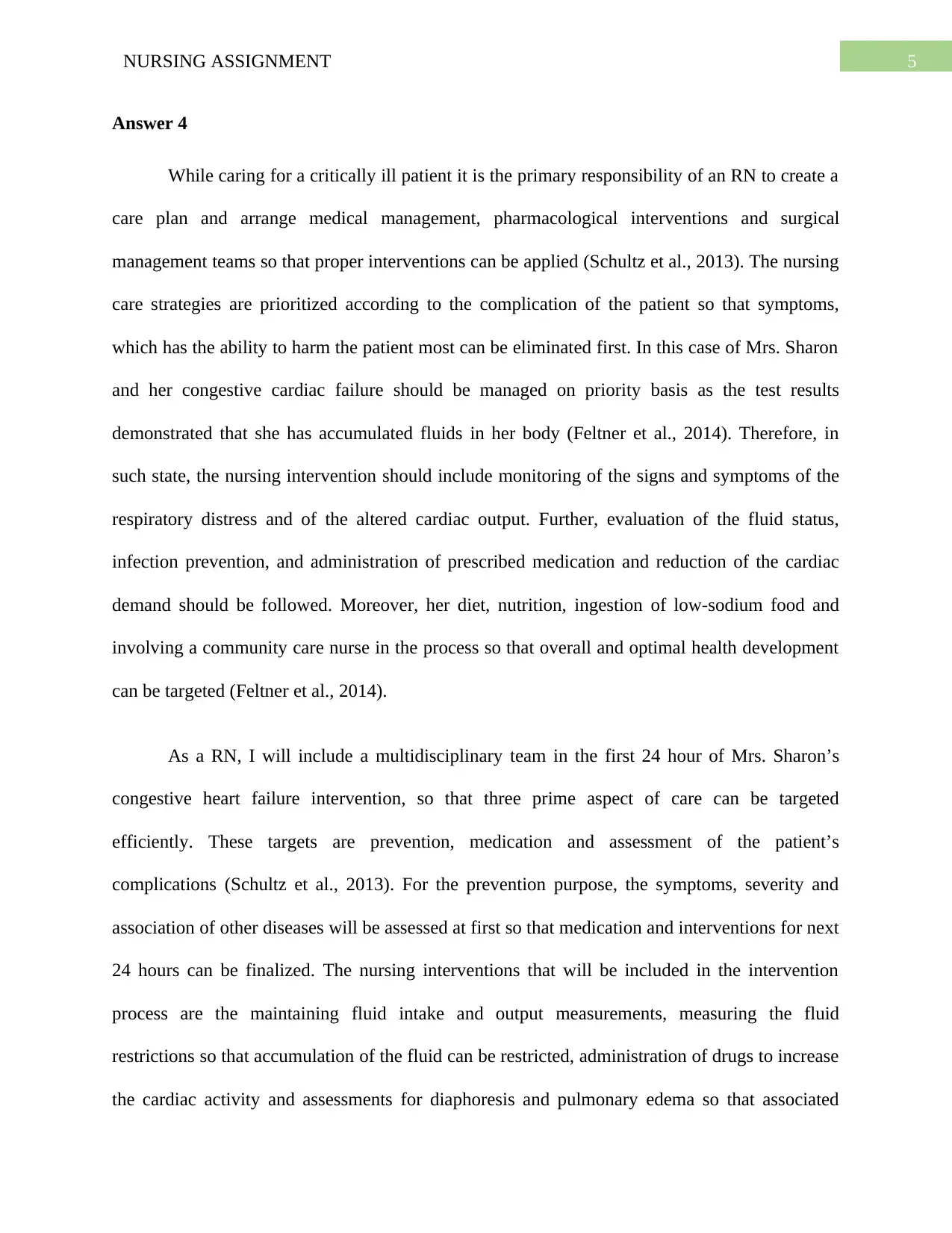
5NURSING ASSIGNMENT
Answer 4
While caring for a critically ill patient it is the primary responsibility of an RN to create a
care plan and arrange medical management, pharmacological interventions and surgical
management teams so that proper interventions can be applied (Schultz et al., 2013). The nursing
care strategies are prioritized according to the complication of the patient so that symptoms,
which has the ability to harm the patient most can be eliminated first. In this case of Mrs. Sharon
and her congestive cardiac failure should be managed on priority basis as the test results
demonstrated that she has accumulated fluids in her body (Feltner et al., 2014). Therefore, in
such state, the nursing intervention should include monitoring of the signs and symptoms of the
respiratory distress and of the altered cardiac output. Further, evaluation of the fluid status,
infection prevention, and administration of prescribed medication and reduction of the cardiac
demand should be followed. Moreover, her diet, nutrition, ingestion of low-sodium food and
involving a community care nurse in the process so that overall and optimal health development
can be targeted (Feltner et al., 2014).
As a RN, I will include a multidisciplinary team in the first 24 hour of Mrs. Sharon’s
congestive heart failure intervention, so that three prime aspect of care can be targeted
efficiently. These targets are prevention, medication and assessment of the patient’s
complications (Schultz et al., 2013). For the prevention purpose, the symptoms, severity and
association of other diseases will be assessed at first so that medication and interventions for next
24 hours can be finalized. The nursing interventions that will be included in the intervention
process are the maintaining fluid intake and output measurements, measuring the fluid
restrictions so that accumulation of the fluid can be restricted, administration of drugs to increase
the cardiac activity and assessments for diaphoresis and pulmonary edema so that associated
Answer 4
While caring for a critically ill patient it is the primary responsibility of an RN to create a
care plan and arrange medical management, pharmacological interventions and surgical
management teams so that proper interventions can be applied (Schultz et al., 2013). The nursing
care strategies are prioritized according to the complication of the patient so that symptoms,
which has the ability to harm the patient most can be eliminated first. In this case of Mrs. Sharon
and her congestive cardiac failure should be managed on priority basis as the test results
demonstrated that she has accumulated fluids in her body (Feltner et al., 2014). Therefore, in
such state, the nursing intervention should include monitoring of the signs and symptoms of the
respiratory distress and of the altered cardiac output. Further, evaluation of the fluid status,
infection prevention, and administration of prescribed medication and reduction of the cardiac
demand should be followed. Moreover, her diet, nutrition, ingestion of low-sodium food and
involving a community care nurse in the process so that overall and optimal health development
can be targeted (Feltner et al., 2014).
As a RN, I will include a multidisciplinary team in the first 24 hour of Mrs. Sharon’s
congestive heart failure intervention, so that three prime aspect of care can be targeted
efficiently. These targets are prevention, medication and assessment of the patient’s
complications (Schultz et al., 2013). For the prevention purpose, the symptoms, severity and
association of other diseases will be assessed at first so that medication and interventions for next
24 hours can be finalized. The nursing interventions that will be included in the intervention
process are the maintaining fluid intake and output measurements, measuring the fluid
restrictions so that accumulation of the fluid can be restricted, administration of drugs to increase
the cardiac activity and assessments for diaphoresis and pulmonary edema so that associated
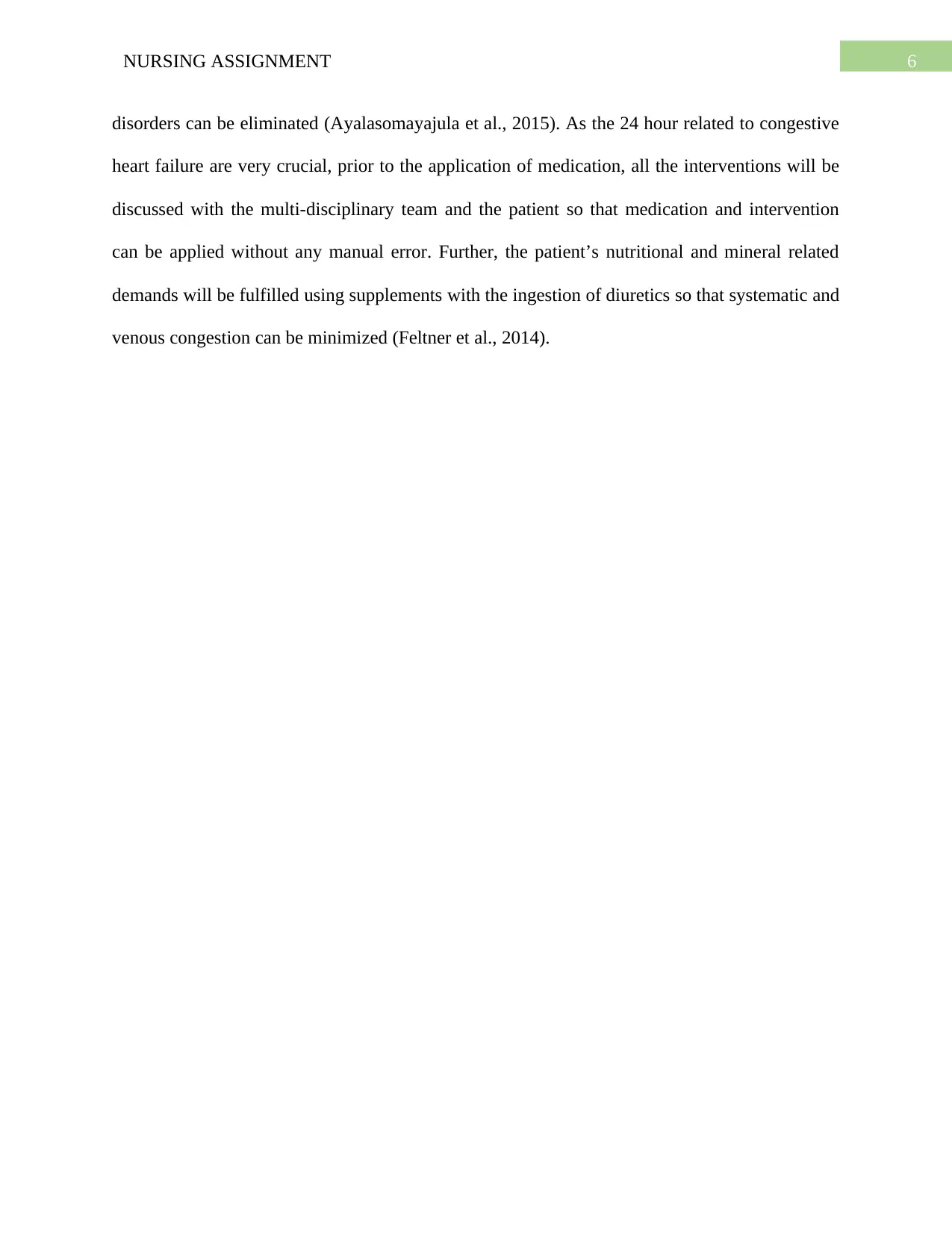
6NURSING ASSIGNMENT
disorders can be eliminated (Ayalasomayajula et al., 2015). As the 24 hour related to congestive
heart failure are very crucial, prior to the application of medication, all the interventions will be
discussed with the multi-disciplinary team and the patient so that medication and intervention
can be applied without any manual error. Further, the patient’s nutritional and mineral related
demands will be fulfilled using supplements with the ingestion of diuretics so that systematic and
venous congestion can be minimized (Feltner et al., 2014).
disorders can be eliminated (Ayalasomayajula et al., 2015). As the 24 hour related to congestive
heart failure are very crucial, prior to the application of medication, all the interventions will be
discussed with the multi-disciplinary team and the patient so that medication and intervention
can be applied without any manual error. Further, the patient’s nutritional and mineral related
demands will be fulfilled using supplements with the ingestion of diuretics so that systematic and
venous congestion can be minimized (Feltner et al., 2014).
Paraphrase This Document
Need a fresh take? Get an instant paraphrase of this document with our AI Paraphraser
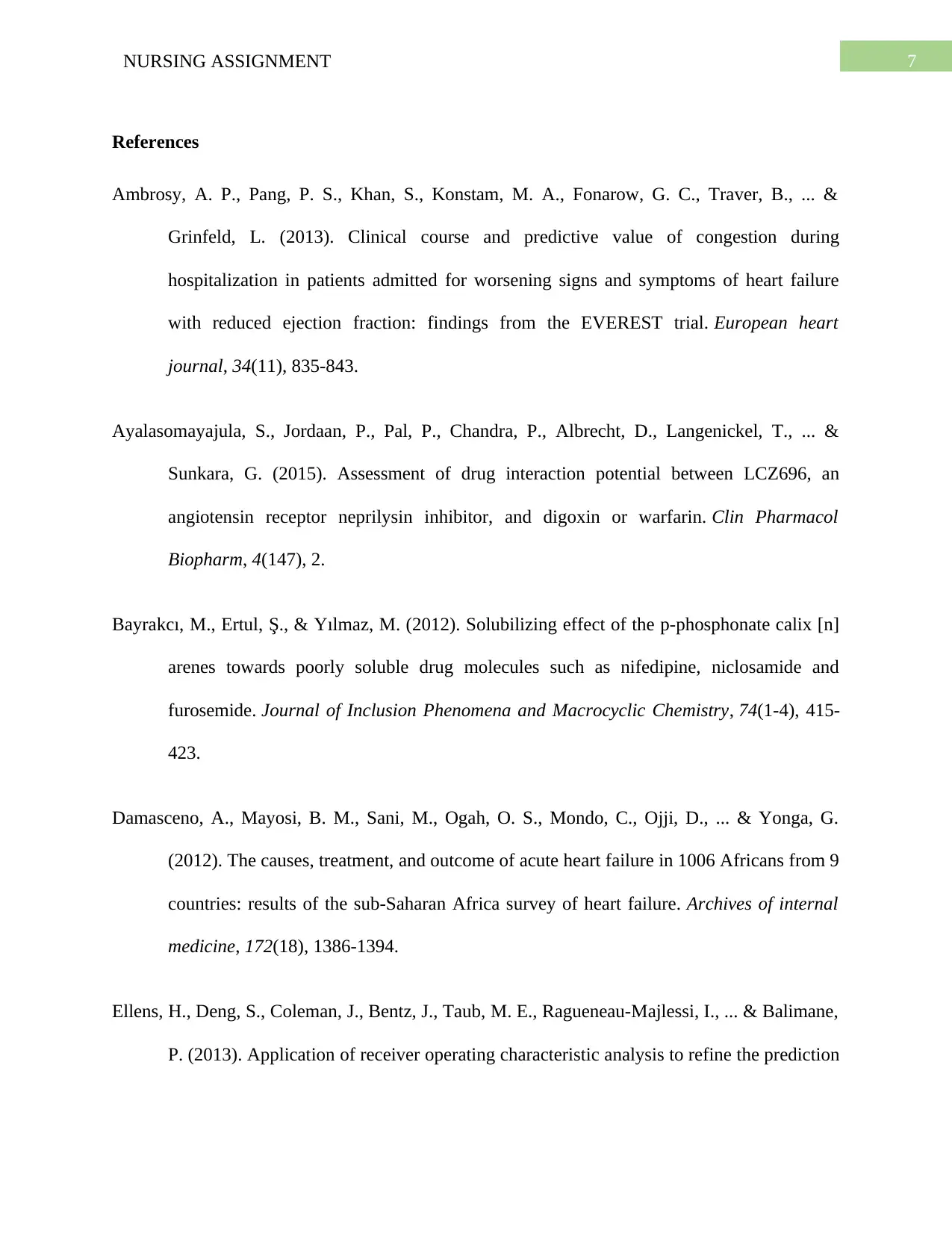
7NURSING ASSIGNMENT
References
Ambrosy, A. P., Pang, P. S., Khan, S., Konstam, M. A., Fonarow, G. C., Traver, B., ... &
Grinfeld, L. (2013). Clinical course and predictive value of congestion during
hospitalization in patients admitted for worsening signs and symptoms of heart failure
with reduced ejection fraction: findings from the EVEREST trial. European heart
journal, 34(11), 835-843.
Ayalasomayajula, S., Jordaan, P., Pal, P., Chandra, P., Albrecht, D., Langenickel, T., ... &
Sunkara, G. (2015). Assessment of drug interaction potential between LCZ696, an
angiotensin receptor neprilysin inhibitor, and digoxin or warfarin. Clin Pharmacol
Biopharm, 4(147), 2.
Bayrakcı, M., Ertul, Ş., & Yılmaz, M. (2012). Solubilizing effect of the p-phosphonate calix [n]
arenes towards poorly soluble drug molecules such as nifedipine, niclosamide and
furosemide. Journal of Inclusion Phenomena and Macrocyclic Chemistry, 74(1-4), 415-
423.
Damasceno, A., Mayosi, B. M., Sani, M., Ogah, O. S., Mondo, C., Ojji, D., ... & Yonga, G.
(2012). The causes, treatment, and outcome of acute heart failure in 1006 Africans from 9
countries: results of the sub-Saharan Africa survey of heart failure. Archives of internal
medicine, 172(18), 1386-1394.
Ellens, H., Deng, S., Coleman, J., Bentz, J., Taub, M. E., Ragueneau-Majlessi, I., ... & Balimane,
P. (2013). Application of receiver operating characteristic analysis to refine the prediction
References
Ambrosy, A. P., Pang, P. S., Khan, S., Konstam, M. A., Fonarow, G. C., Traver, B., ... &
Grinfeld, L. (2013). Clinical course and predictive value of congestion during
hospitalization in patients admitted for worsening signs and symptoms of heart failure
with reduced ejection fraction: findings from the EVEREST trial. European heart
journal, 34(11), 835-843.
Ayalasomayajula, S., Jordaan, P., Pal, P., Chandra, P., Albrecht, D., Langenickel, T., ... &
Sunkara, G. (2015). Assessment of drug interaction potential between LCZ696, an
angiotensin receptor neprilysin inhibitor, and digoxin or warfarin. Clin Pharmacol
Biopharm, 4(147), 2.
Bayrakcı, M., Ertul, Ş., & Yılmaz, M. (2012). Solubilizing effect of the p-phosphonate calix [n]
arenes towards poorly soluble drug molecules such as nifedipine, niclosamide and
furosemide. Journal of Inclusion Phenomena and Macrocyclic Chemistry, 74(1-4), 415-
423.
Damasceno, A., Mayosi, B. M., Sani, M., Ogah, O. S., Mondo, C., Ojji, D., ... & Yonga, G.
(2012). The causes, treatment, and outcome of acute heart failure in 1006 Africans from 9
countries: results of the sub-Saharan Africa survey of heart failure. Archives of internal
medicine, 172(18), 1386-1394.
Ellens, H., Deng, S., Coleman, J., Bentz, J., Taub, M. E., Ragueneau-Majlessi, I., ... & Balimane,
P. (2013). Application of receiver operating characteristic analysis to refine the prediction
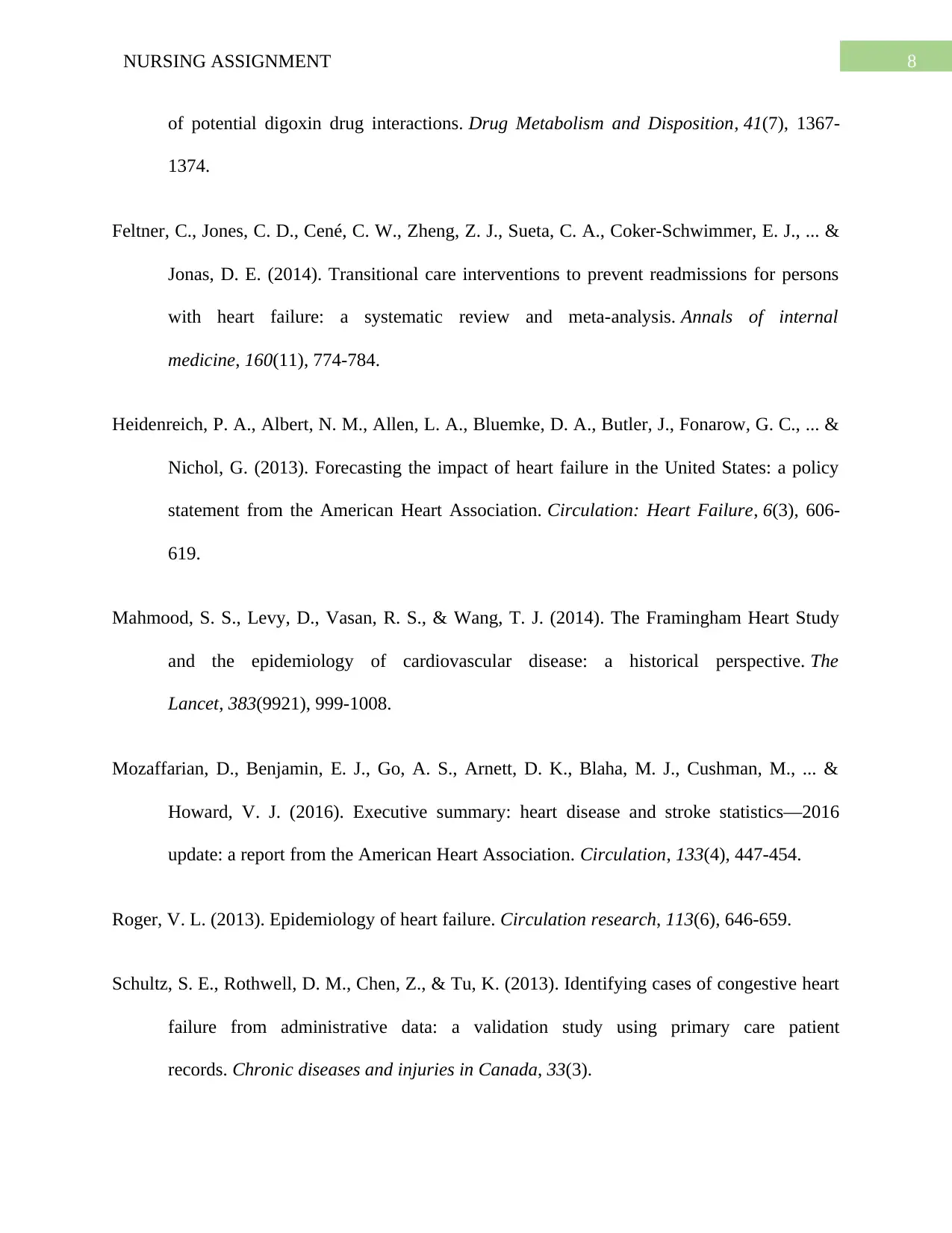
8NURSING ASSIGNMENT
of potential digoxin drug interactions. Drug Metabolism and Disposition, 41(7), 1367-
1374.
Feltner, C., Jones, C. D., Cené, C. W., Zheng, Z. J., Sueta, C. A., Coker-Schwimmer, E. J., ... &
Jonas, D. E. (2014). Transitional care interventions to prevent readmissions for persons
with heart failure: a systematic review and meta-analysis. Annals of internal
medicine, 160(11), 774-784.
Heidenreich, P. A., Albert, N. M., Allen, L. A., Bluemke, D. A., Butler, J., Fonarow, G. C., ... &
Nichol, G. (2013). Forecasting the impact of heart failure in the United States: a policy
statement from the American Heart Association. Circulation: Heart Failure, 6(3), 606-
619.
Mahmood, S. S., Levy, D., Vasan, R. S., & Wang, T. J. (2014). The Framingham Heart Study
and the epidemiology of cardiovascular disease: a historical perspective. The
Lancet, 383(9921), 999-1008.
Mozaffarian, D., Benjamin, E. J., Go, A. S., Arnett, D. K., Blaha, M. J., Cushman, M., ... &
Howard, V. J. (2016). Executive summary: heart disease and stroke statistics—2016
update: a report from the American Heart Association. Circulation, 133(4), 447-454.
Roger, V. L. (2013). Epidemiology of heart failure. Circulation research, 113(6), 646-659.
Schultz, S. E., Rothwell, D. M., Chen, Z., & Tu, K. (2013). Identifying cases of congestive heart
failure from administrative data: a validation study using primary care patient
records. Chronic diseases and injuries in Canada, 33(3).
of potential digoxin drug interactions. Drug Metabolism and Disposition, 41(7), 1367-
1374.
Feltner, C., Jones, C. D., Cené, C. W., Zheng, Z. J., Sueta, C. A., Coker-Schwimmer, E. J., ... &
Jonas, D. E. (2014). Transitional care interventions to prevent readmissions for persons
with heart failure: a systematic review and meta-analysis. Annals of internal
medicine, 160(11), 774-784.
Heidenreich, P. A., Albert, N. M., Allen, L. A., Bluemke, D. A., Butler, J., Fonarow, G. C., ... &
Nichol, G. (2013). Forecasting the impact of heart failure in the United States: a policy
statement from the American Heart Association. Circulation: Heart Failure, 6(3), 606-
619.
Mahmood, S. S., Levy, D., Vasan, R. S., & Wang, T. J. (2014). The Framingham Heart Study
and the epidemiology of cardiovascular disease: a historical perspective. The
Lancet, 383(9921), 999-1008.
Mozaffarian, D., Benjamin, E. J., Go, A. S., Arnett, D. K., Blaha, M. J., Cushman, M., ... &
Howard, V. J. (2016). Executive summary: heart disease and stroke statistics—2016
update: a report from the American Heart Association. Circulation, 133(4), 447-454.
Roger, V. L. (2013). Epidemiology of heart failure. Circulation research, 113(6), 646-659.
Schultz, S. E., Rothwell, D. M., Chen, Z., & Tu, K. (2013). Identifying cases of congestive heart
failure from administrative data: a validation study using primary care patient
records. Chronic diseases and injuries in Canada, 33(3).
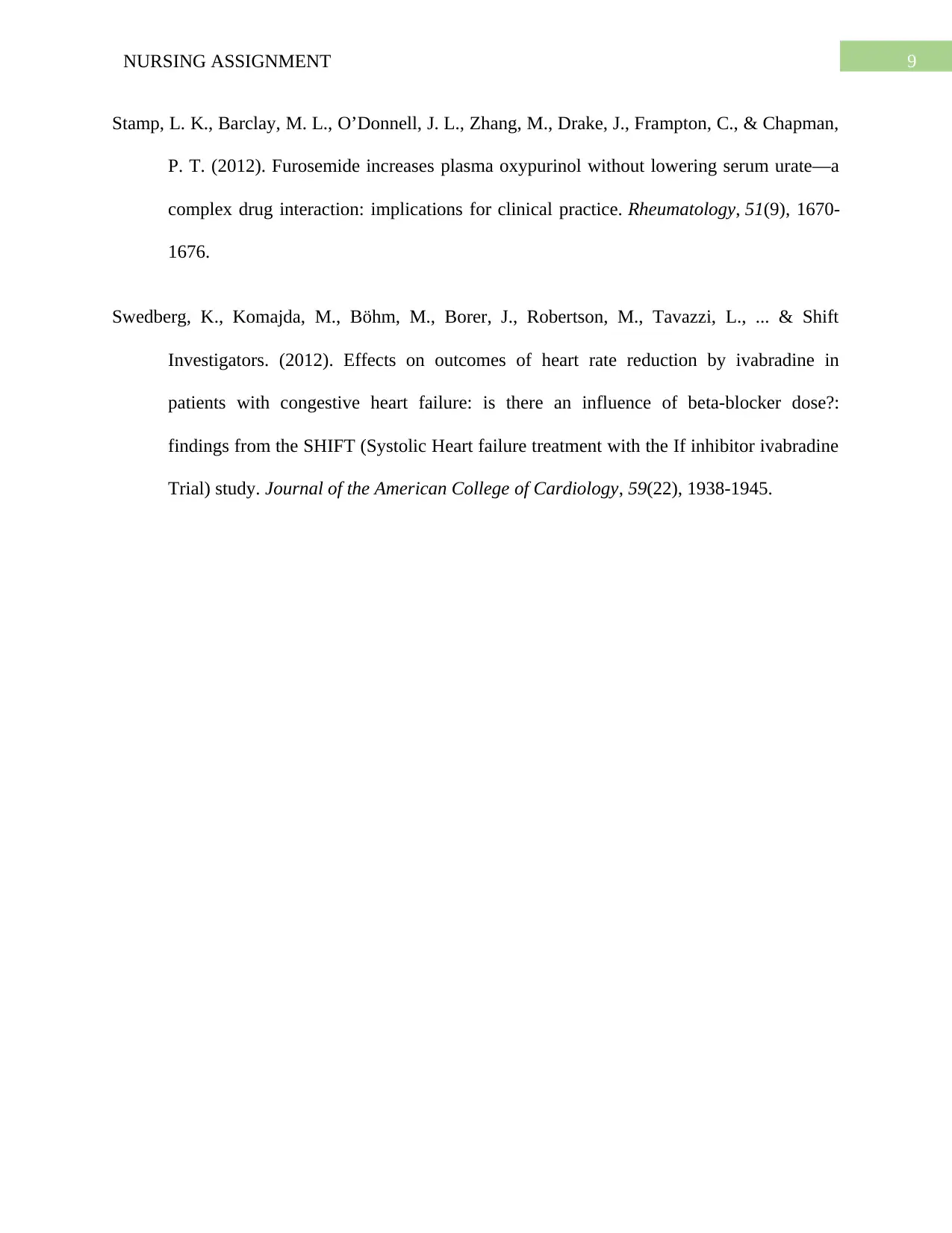
9NURSING ASSIGNMENT
Stamp, L. K., Barclay, M. L., O’Donnell, J. L., Zhang, M., Drake, J., Frampton, C., & Chapman,
P. T. (2012). Furosemide increases plasma oxypurinol without lowering serum urate—a
complex drug interaction: implications for clinical practice. Rheumatology, 51(9), 1670-
1676.
Swedberg, K., Komajda, M., Böhm, M., Borer, J., Robertson, M., Tavazzi, L., ... & Shift
Investigators. (2012). Effects on outcomes of heart rate reduction by ivabradine in
patients with congestive heart failure: is there an influence of beta-blocker dose?:
findings from the SHIFT (Systolic Heart failure treatment with the If inhibitor ivabradine
Trial) study. Journal of the American College of Cardiology, 59(22), 1938-1945.
Stamp, L. K., Barclay, M. L., O’Donnell, J. L., Zhang, M., Drake, J., Frampton, C., & Chapman,
P. T. (2012). Furosemide increases plasma oxypurinol without lowering serum urate—a
complex drug interaction: implications for clinical practice. Rheumatology, 51(9), 1670-
1676.
Swedberg, K., Komajda, M., Böhm, M., Borer, J., Robertson, M., Tavazzi, L., ... & Shift
Investigators. (2012). Effects on outcomes of heart rate reduction by ivabradine in
patients with congestive heart failure: is there an influence of beta-blocker dose?:
findings from the SHIFT (Systolic Heart failure treatment with the If inhibitor ivabradine
Trial) study. Journal of the American College of Cardiology, 59(22), 1938-1945.
1 out of 10
Related Documents
Your All-in-One AI-Powered Toolkit for Academic Success.
+13062052269
info@desklib.com
Available 24*7 on WhatsApp / Email
![[object Object]](/_next/static/media/star-bottom.7253800d.svg)
Unlock your academic potential
© 2024 | Zucol Services PVT LTD | All rights reserved.




